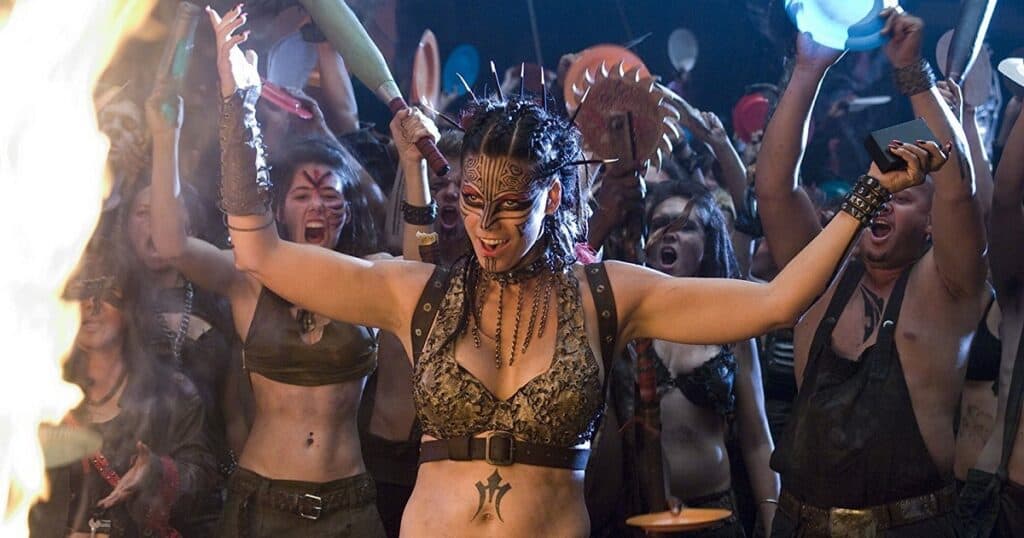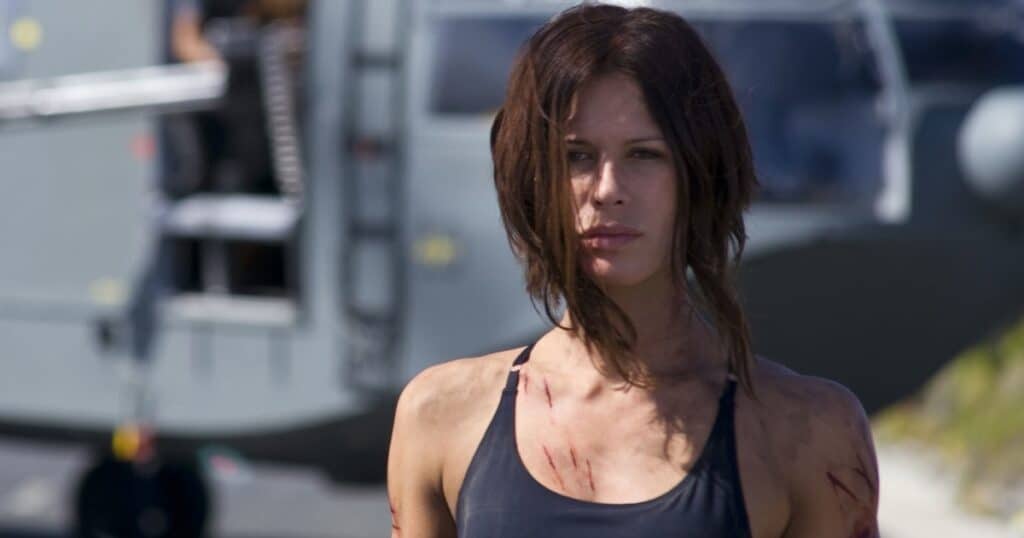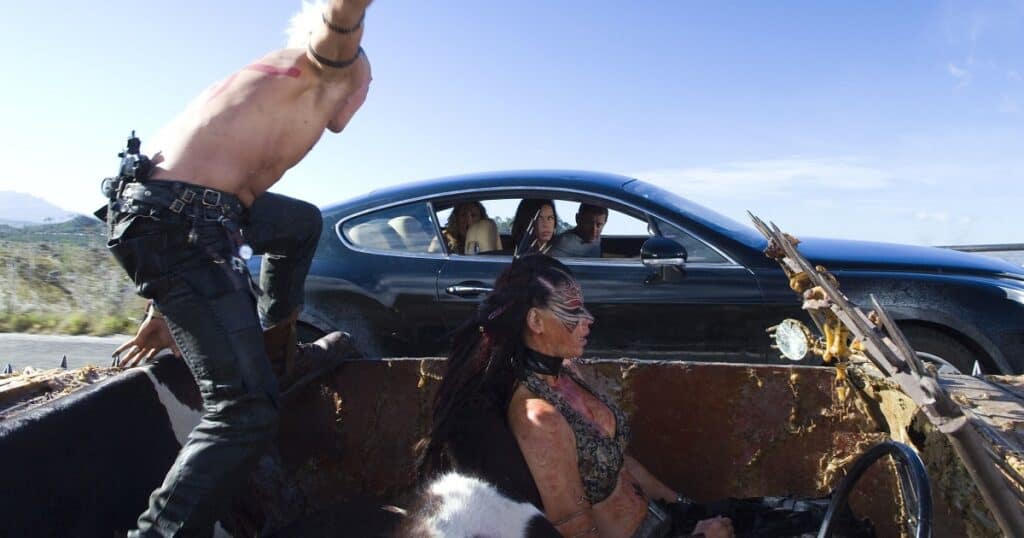
Imagine a world pushed to the brink of collapse, where civilization teeters on the edge of oblivion. In this landscape of chaos and desperation, one film dared to envision a future both terrifying and exhilarating. Welcome to Doomsday, a gritty and adrenaline-fueled journey into the heart of darkness. Released in 2008 and directed by Neil Marshall, Doomsday (watch it HERE) thrusts audiences into a post-apocalyptic wasteland where survival is not guaranteed and every choice could mean life or death. As we revisit this cinematic rollercoaster ride, we’re invited to explore themes of resilience, humanity’s capacity for both destruction and redemption, and the timeless allure of the apocalypse…something that feels all too familiar in today’s climate. Join us, as we dig deeper into a film that not only feels densely layered, but also feels like multiple movies we’ve seen before on this episode of Horror Revisited.
Neil Marshall… that’s a name most fans of horror films have come to know and love. If this is your first time, then let us quickly brief you on him. Marshall began his career working in various capacities in the film industry, including as a film editor and cinematographer. He gained experience working on commercials, music videos, and short films before transitioning to directing.
In 2002, Marshall directed his first film, Dog Soldiers. It follows a group of British soldiers who find themselves battling werewolves in the Scottish Highlands. The film received critical acclaim for its blend of action, horror, and humor, establishing Marshall as a promising talent in the genre. In 2005, he released a film that to this day haunts this writer. The movie was called The Descent. In it, we follow a group of women who become trapped in an unexplored cave system inhabited by terrifying creatures. Praised for its claustrophobic atmosphere, intense scares, and strong female characters, The Descent solidified Marshall’s reputation as a master of horror.
Sometime after he had solidified himself in the genre, Marshall wanted to take a stab at something else…something new. He lived near Hadrian’s Wall. Back in AD122, Roman’s created a wall that was built to defend England against Scotland’s tribes. Marshall started thinking up ideas on how to make that into a movie. He would add a killer virus to the mix as well. He had favored the English/Scottish border as the location for rebuilding the wall. Scotland is home to many medieval castles as well, which fit the aesthetic Marshall was looking for.
Now I know what you’re thinking and yes, Doomsday heavily borrows elements from multiple films. Just to stay on track and not cite this scene by scene, we will list the major movies it borrows from the most. We’ve got the Mad Max series, Escape from New York, Resident Evil, Underworld, Excalibur, Waterworld, Gladiator, Children of Men and 28 Days Later.

With influence from all these films, how in the world could Neil have created something that stood on its own? The plot for the film is as follows: In 2008, a deadly virus called the Reaper virus strikes Scotland, leading to a government-enforced quarantine. In 2035 the virus resurfaces in London, threatening to spread worldwide, Major Eden Sinclair leads a team into Scotland to find a cure. While inside, they encounter savage tribes, cannibalistic scavengers, and other survivors, searching for Dr. Kane, a scientist who may hold the key to a cure. As they navigate the treacherous landscape, tensions rise and betrayals occur within the team. Ultimately, they uncover a shocking truth about the virus and must fight for survival against both the infected and the government’s hidden agenda.
Instead of copying the 28 Days Later series, this virus acts like a plague that devastated the population, no one is turning into an aggressive zombie eating machine. He had intended that the virus serve as backdrop, having survivors fend for themselves to set up a primitive society and boy did he depict them as brutal, killing machines. Marshall wanted to pay tribute to the 1970s and 80’s post-apocalyptic films. He is quoted as saying “Right from the star, I wanted my film to an homage to these sorts of movies and deliberately so. I wanted to make a movie for a new generation of audience that hadn’t seen those movies in the cinema – hadn’t seen them at all maybe – and give them the same thrill that I got watching them. But kind of contemporise it, pump up the action and the blood and guts.”
When time came for casting, he picked some great standout actors. First up, for the main role, Rhona Mitra was hired. She has been compared in her past to Kate Beckinsale. She even played a young Sonja in Underworld: Rise of the Lycans. Rhona’s role of Eden Sinclair is very similar to Snake Plissken, and it shows. For the role, she would work out constantly and train incredibly hard for her fight scenes and it shows, when the camera is visible. Originally, she was written to spout quip after quip, but instead she was written as more of a badass. In the end, she works better as the strong, silent type. We also see the late great Bob Hoskins, David O’Hara, Malcolm McDowell, Alexander Siddig, Adrian Lester and Craig Conway as the sadistic Sol.
Back in October 2005, Rogue Pictures etched their deal with Neil Marshall to direct the film. In November 2006, Rhona Mitra would sign on to star in the film. The production’s budget was estimated around £17 million. This would also be the highest budget, at the time, that Marshall had been given. He was only used to small casts and locations so he was excited to take on the broader experience.
Principal photography began in February 2007 in South Africa. Even though the majority of the film takes place in London and Scotland, South Africa was chosen for filming because of monetary reasons…basically, it was cheaper than shooting in London. Marshall loved the landscape and thought it was the closest the movie could get to looking like Scotland. Filming took place for 55 days in South Africa, with another 10 taking place in Scotland. Production in Scotland was filmed in Glasglow at Blackness Castle.
Some scenes were cut from filming, including one that involved a helicopter gunship attacking a medieval castle. There was a massive car chase scene filmed for the ending. If you’ve seen the movie, you’ll know that Rhona Mitra and the remaining survivors unbox a Bentley Continental GT and use it to escape Kane and his cronies. Since Bentley didn’t do product placement, the crew purchased three new ones, each costing $150,000. One car was driven into a gorge and another was used for most of the stunt shots. Once filming was completed, the car needed cosmetic retouches, but its frame and engine stayed intact. I guess a Bentley is the car to choose when living in a post apocalyptic world.

Simon Bowles was the production designer and had worked with Marshall on his previous films. Paul Hyett, who was hired as a prosthetic make-up designer, researched diseases including STDs to design the make-up for the Reaper virus victims.
Let’s discuss the visual effects because there were approximately 275 of them. Some shots were used for set extensions, unfortunately a victim of budget restrictions. Most shots took place during the day, so the extensions involved matte paint and 2D and 3D solutions. The visual effects crew flew to Scotland and took tons of reference photos. Anything that was filmed in Cape Town, South Africa could instead have Scottish backgrounds. A big challenge for the VFX crew included the creation of the rebuilt Hadrian Wall in different lights and from different distances. Shockingly, a very challenging shot consisted of a close-up in which a main character is burned alive. This shot required multiple enhancements and implementations of burning wardrobe, burning pigskin, and smoke and fire elements to look authentic
Back to the car chase sequence. While George Miller implemented tons of pyrotechnics and real stunts in his Max Max series, that wouldn’t be the case here. One of the big shots, and was featured in the trailer, involves a Bentley crashing through a bus. Pyrotechnics were going to be used, but fire marshals in the South African nature reserve, forbid their use due to dry conditions. A miniature mock-up was created and visual effects were applied so the filming of the mock-up would overlay the filming of the actual scene without pyrotechnics.
Marshall hired Tyler Bates to compose the score for the film. Originally, Neil’s intention was to include 1980’s synth music, but found it to be difficult to combine with the pacing. Tyler’s score that was composed consisted of heavy orchestra music. The movie also boasts a pretty great soundtrack including songs from Adam and the Ants, Fine Young Cannibals, Siouxise and the Banshees, Frankie Goes to Hollywood and Kasabian.
Doomsday opened on March 14, 2008 under Universal Pictures’ distribution for large scale marketing. It ranked seventh on opening weekend against Horton Hears a Who! And Never Back Down. After it’s first box office weekend, it would vanish from the top 10 and on April 10, it would end it’s theatrical run in the US and Canada grossing a mere $11 million. It would open later internationally and gross another $11 million. It’s worldwide total would end around $22 million.
The film currently holds a 50% on Rotten Tomatoes with the critics conesus being “Doomsday is a pale imitation of previous futuristic thrillers, minus the cohesive narrative and charismatic leads”. It unfortunately wasn’t screened for critics. Alison Rowat of the Herald said “In his previous films, Marshall made something out of nothing. Here he does the opposite”. James Berardinelli called Doomsday’s production a mess saying the action would be more tense if it wasn’t ruined by rapid-fire editing.
Scotland’s tourism agency VisitScotland was hoping that the film would attract tourism by marketing Scotland to the rest of the world. The country’s national body for film and television, Scottish Screen, had contributed £300,000 to the production. Several parties expressed concern that the film brought negativity in England’s view of Scotland based on their history.
Doomsday was not nominated or considered as a possible contender at the BAFTA Scotland awards despite being one of the largest film productions in Scotland in years. Neil Marshall applied for membership with the organization to add “fresh blood”, but Doomsday was not mentioned during jury deliberations.

Doomsday was released on DVD and Blu-ray on July 29, 2008. It would be packaged as the unrated version of the film, but would also include the theatrical version as well…if you preferred the 5% less gruesome film. It would come packed with commentary by Marshall and cast members, featurettes on the post-apocalypse depicted in the film, visual effects and destructive vehicles and weapons. For any fan of this movie, I highly recommend the commentary. It’s here you’ll gain a better background for the production and what went into making the film.
This movie is action packed and filled with adrenaline-pumping sequences. There are some that truly stand out and made this a fun rewatch. Let’s begin with the opening sequence. It set the tone immediately with a gripping prologue showing the outbreak of the Reaper virus and the government’s desperate measures to contain it, including the construction of the massive wall that surrounds Scotland. While some films just throw you into the scenario and you are just expected to follow, Doomsday does one better and offers you a gripping and tense reality that feels all too real nowadays. Another fun, albeit hard scene to truly see, is the Gladiator Arena scene. It’s full of fast-paced action and includes frenetic energy throughout. It has everything you’re looking for: intense hand-to-hand combat, sword fights, and brutal melee combat. Now to the piece de resistance of the film, and my absolute most favorite part…the car chase scene. It combines fast-paced driving, daring maneuvers, and explosive collisions to create a thrilling sequence that keeps you on the edge of your seat. While the editing is choppy throughout, it actually works to the film’s advantage. Also,you’re being treated to a perfect chase song, “Two Tribes” by Frankie Goes To Hollywood…what’s not to love?
Upon revisiting Doomsday, I’ve come up with both some positive and negative feelings about the film. It boasts impressive production design and cinematography, creating a gritty and atmospheric post-apocalyptic world, which make its dystopian landscape feel vivid and believable. Rhona Mitra shines in her role as Major Eden Sinclair, bringing a compelling blend of toughness and vulnerability to the character. Her strong presence also anchors the film ands keeps us invested. While it does pay homage to many films before it, Doomsday struggles to carve out its own identity. It also falls short in terms of plot. The storyline is straightforward and lacks nuance, and many of the supporting characters feel underdeveloped, making it challenging for viewers to emotionally invest in their arcs. While the film is packed with action, it occasionally suffers from pacing issues, particularly in the second act. Some scenes feel drawn out or repetitive, slowing the momentum of the narrative and making the pacing feel uneven at times. But, my biggest gripe is the open-ended ending. Some things are never explained or talked about again and the film just ends. There are many plot points that I wish would have been further shown but unfortunately we will never know.
I know that this film has its fans, but after having seen this with fresh eyes, over 15 years later, after dealing with a pandemic, it just falls short and fails to fully capitalize on its potential. While its action sequences are undeniably thrilling, visually striking, and at times hard to see, the movie struggles to offer a substantial narrative framework or develop its characters beyond surface-level archetypes.
Moving forward, this could have benefitted from a more robust screenplay that delves into the complexities of its post-apocalyptic world and the motivations of its characters. By investing in stronger character development and exploring deeper thematic elements, the film could have elevated itself beyond being a mere homage to genre tropes and emerged as a more thought-provoking and emotionally resonant cinematic experience. While Doomsday remains an entertaining ride for fans of action-packed dystopian thrillers, it serves as a reminder of the importance of substance over style in crafting truly memorable and impactful cinema.
Two previous episodes of Revisited can be seen below. To see more of our shows, head over to the JoBlo Horror Originals channel – and subscribe while you’re at it!
The post Doomsday (2008) Revisited – Horror Movie Review appeared first on JoBlo.
Leave a Reply